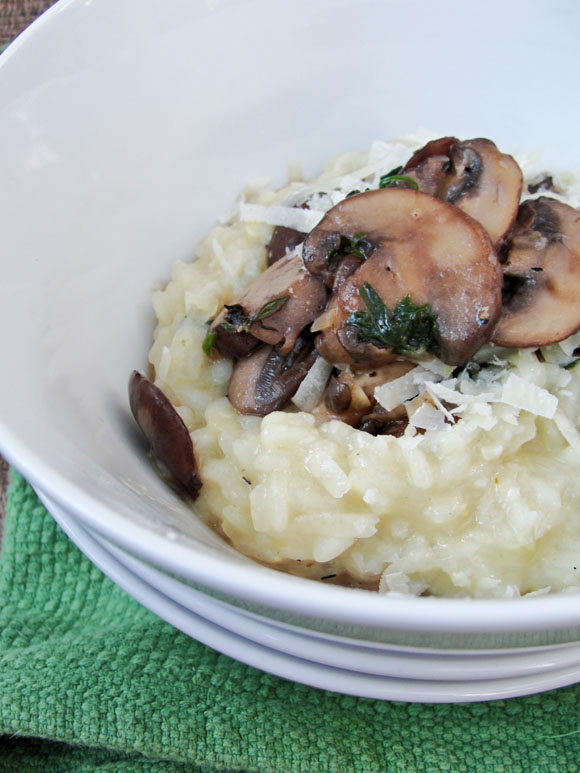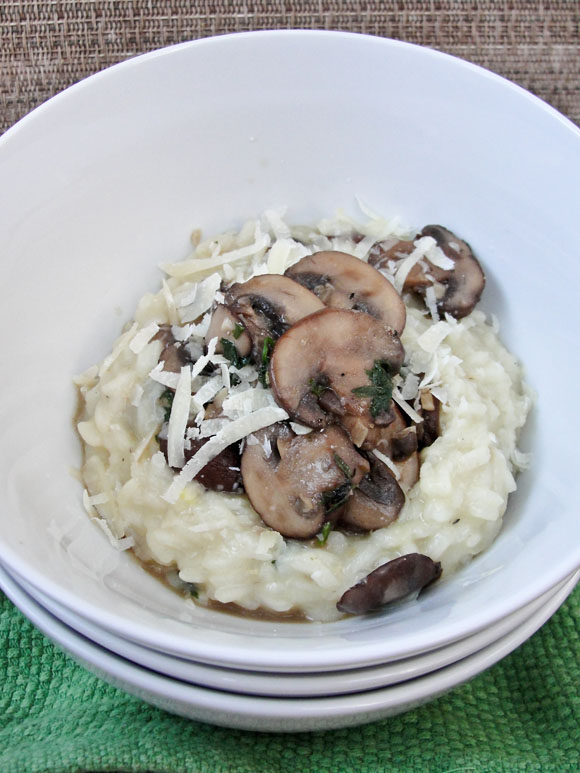GCC: Menu 21 - Mushroom Risotto
 This weeks gutsy cook choice was a favorite of mine – Risotto, in this case with mushrooms.
This weeks gutsy cook choice was a favorite of mine – Risotto, in this case with mushrooms.
Most people fear risotto, they think that its complicated and risky. Requiring constant, slow stirring, attention to detail and patience. With no short cuts allowed. Even for a season cook the pressure to turn a great risotto dish may be too much.
You may think that being Italian I cooked this dish many time. Not so, the first time I ever made risotto was last year. As part of a Daring Cook Challenge. Since then, I have made it so many times and can tell you, there is no need to panic. Risotto is not that difficult, in fact, it is one of the easiest dishes to make, but like anything in the kitchen, the trick is organization before hand. Risotto is all about technique. Once you master it, you will be whipping it up and experimenting with countless seasonal flavors.
A perfect risotto starts with the perfect rice, and there are three main varieties from which to choose: arborio, vialone nano and carnaroli. All three are high in starch that dissolves in the cooking process, giving risotto its characteristic creaminess and slightly clingy texture.
My grandmother always use to tell me that there were four rules to making risotto:
- Always use a wide, heavy saucepan or skillet (if the pan is too light, the risotto can burn).
- Use a wooden spoon to stir the rice.
- Always use HOT stock (preferably homemade) and always make more than what you think you may need, the rice may absorb less or more, and you don’t want to end up needing more in the middle of cooking your risotto.
- And last, my nonna use to say “Risotto non aspetta nessuno” (Risotto does not wait for anyone). Serve risotto immediately. Sitting for even 10 minutes on the counter will adversely affect the texture, making it clumpy and gooey.
Once that rice hits the saucepan, you are committed.
The rice is first cooked briefly in a soffritto of onion or garlic and butter or olive oil to coat each grain in a film of fat, this is called “tostatura”; white or red wine is added and has to be absorbed by the grains. When it has evaporated, the heat is raised to medium high and very hot stock is gradually added in small amounts while stirring gently, almost constantly (more on that later): stirring loosens the starch molecules from the outside of the rice grains into the surrounding liquid, creating a smooth creamy-textured liquid.
At that point it is taken off the heat for the “mantecatura” when diced cold butter and finely grated Parmigiano-Reggiano cheese are vigorously stirred in to make the texture as creamy and smooth as possible. It may be removed from the heat a few minutes earlier, and left to cook with its residual heat. Fish and seafood risotto generally do not include cheese.
Properly cooked risotto is rich and creamy but still with some resistance or bite: al dente, and with separate grains. The traditional texture is fairly fluid, or all’onda (“wavy, or flowing in waves”). It is served on flat dishes and it should easily spread out but not have excess watery liquid around the perimeter.

Mushroom Risotto
Serves 4-6, Adapted from The Kitchen Bible
For the Mushrooms:
- 1 tablespoon of butter
- 1 tablespoon of olive oil
- ½ onion, chopped
- 1 pound of wild mushrooms mix or cremini/baby bella – roughly chopped
- 1 tablespoon of chopped garlic, fine
- 4 tablespoon of white wine
- 2 tablespoon of parley, chopped
- salt and ground pepper to taste
For the risotto:
- 4 tablespoons olive oil
- 1 onion, chopped
- 2 cups arborio or carnaroli rice
- 6 to 8 cups hot vegetable (or chicken) stock - kept simmering
- 2 tablespoons butter, diced
- Previously cooked mushrooms
- ½ cup freshly grated Parmesan
- Start by heating the stock you will be using, by placing it in a saucepan and heat to simmer and keep it there.
- Next up the mushrooms. In a heavy skillet, melt the butter over medium high heat, when bubbling add the olive oil and the chopped onions. Stir and cook until translucent. Add the mushrooms and season with salt and ground pepper, stir frequently, browning them and making sure any liquid evaporates. When dry, add the garlic and stir. Then the wine and once more stir until the liquid evaporates. Taste and season with more salt and pepper if needed. Add the chopped parley and then remove them from the skillet to a bowl. Do not rinse the skillet, you are going to reuse for the risotto.
- Place the skillet back over medium heat and add the oil, heat it up for a bit and then add the onion and fry for 5 minutes or until golden, stirring occasionally. Add the rice and stir for 2 minutes.
- Gradually add the stock, about ½ cup at a time, stirring constantly, waiting until it is absorbed before adding more. Continue in this manner for 25 minutes or until the rice is barely tender and has a creamy consistency.
- Stir the butter and about half of the mushrooms into the rice and turn off remove from the heat. Stir in the cheese and serve immediately. Top each plate with the left over mushrooms and sprinkle more cheese.
Tips and tricks:
Don’t try to make risotto for 14 people. It’s just too hard to manage, and the consistency usually suffers. Risotto for two to four is better.
Almost every cook believes (incorrectly) that risotto must be stirred constantly while you’re making it. So it was with joy that I discovered that I could follow my own tendency to walk away from the simmering rice for minutes at a time and still get great risotto. You need to stir no more than occasionally. For example, after each addition of liquid and then once or twice more before that liquid evaporates.
If you’re running late for a dinner party, don’t try to speed up the cooking process by raising the heat on the risotto. You’ll end up with rice that is raw on the inside and sticky on the outside. (Crunching should never be heard when your guests are eating risotto.)

This is part of the Gutsy Cook Club Menu, be sure to check out the other cooks creations by visiting their blogs/sites
